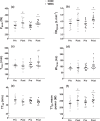Whole-body cryotherapy does not augment adaptations to high-intensity interval training
- PMID: 31427654
- PMCID: PMC6700067
- DOI: 10.1038/s41598-019-48518-1
Whole-body cryotherapy does not augment adaptations to high-intensity interval training
Abstract
The aim of this study was to investigate the effects of regular post-exercise whole-body cryotherapy (WBC) on physiological and performance adaptations to high-intensity interval training (HIT). In a two-group parallel design, twenty-two well-trained males performed four weeks of cycling HIT, with each session immediately followed by 3 min of WBC (-110 °C) or a passive control (CON). To assess the effects of WBC on the adaptive response to HIT, participants performed the following cycling tests before and after the training period; a graded exercise test (GXT), a time-to-exhaustion test (Tmax), a 20-km time trial (20TT), and a 120-min submaximal test (SM120). Blood samples were taken before and after training to measure changes in basal adrenal hormones (adrenaline, noradrenaline, and cortisol). Sleep patterns were also assessed during training via wrist actigraphy. As compared with CON, the administration of WBC after each training session during four weeks of HIT had no effect on peak oxygen uptake ([Formula: see text]O2peak) and peak aerobic power (Ppeak) achieved during the GXT, Tmax duration and work performed (WTmax), 20TT performance, substrate oxidation during the SM120, basal adrenaline/noradrenaline/cortisol concentrations, or sleep patterns (P > 0.05). These findings suggest that regular post-exercise WBC is not an effective strategy to augment training-induced aerobic adaptations to four weeks of HIT.
Conflict of interest statement
The authors declare no competing interests.
Figures




References
Publication types
MeSH terms
Substances
LinkOut - more resources
Full Text Sources
Research Materials

